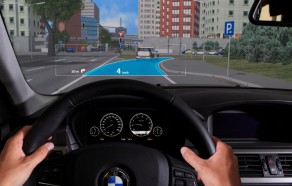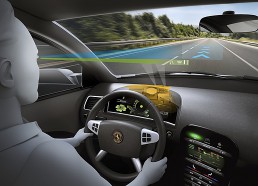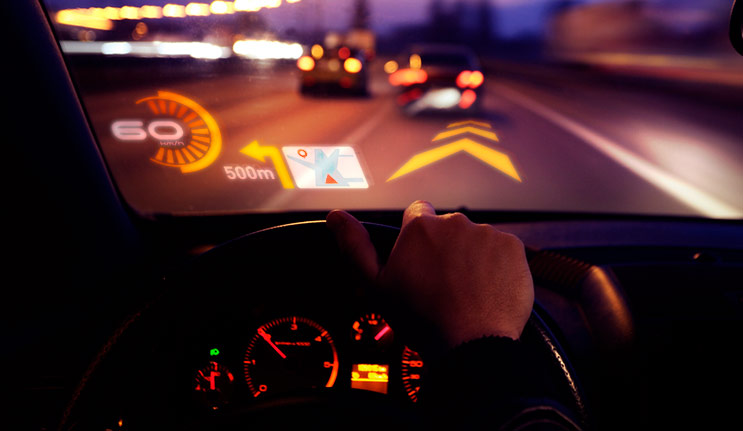No, I’m not referring to the Arkansas Department of Housing and Urban Development. And before you think that I can’t spell or that I’ve gone all pirate on you, AR in this case actually means Augmented Reality. (You know, the place where Kim Jong-un lives). And HUD stands for Heads-Up-Display or when combined “AR-HUDs”. Now that you know a couple of cool new acronyms, how about some visual aids…

Source: Telematics News

Source: SAE International
Do you find any of these images on your windshield distracting? Well unless you’re an ex-fighter pilot or advanced gamer, you will probably need some time and experience to get used to seeing these types of things on your windshield. Personally, I get distracted by the smallest gnat flying around on the inside of my windshield.
AR-HUDs alert drivers to everything from possible collisions to smart phone activity and are meant to make drivers safer. The idea is for the driver to keep their eyes on the road and not looking down at navigation screens or smart phones, etc. But does this technology really help?
According to the University of Toronto researchers, these AR-HUDs may actually be a threat to safety.¹ “Drivers need to divide their attention to deal with this added visual information,” said Department of Psychology professor Ian Spence, who investigated what happens when two sources of information are present in the same visual field.
Spence and his students designed computer-based trials to measure the impact of comingled visual shapes and spots when designated as primary and secondary observation tasks. When visual spots and shapes were presented randomly, the accuracy diminished as the secondary task information increased. In cases with larger numbers of spots, the shape was often misidentified or missed altogether and estimating the number of spots was more difficult when the shape appeared. “Observers made both judgements more slowly when the shape appeared among the spots by as much as 200 percent,” said Spence. “The two visual tasks interfered with each other and impaired both reaction speed and accuracy.”
“Not only will drivers have to concentrate on what’s happening on the road around them as they’ve always done, they’ll also have to attend to whatever warning pops up on the windshield in front of them.” In a real driving situation, you have to be able to identify what is displayed and respond appropriately. “It would be necessary to distinguish, for example, between warnings of a collision and a recommendation to make a turn,” said Spence. “Otherwise competing warnings may be more dangerous than no warning at all.” That’s a pretty cold response to the AR-HUD technology…even for Canadians.
Rear end collisions are a huge problem and if technology can help reduce the risk, frequency and severity of crashes then I say it’s worth it. In 2012 alone, there were over 1.7 million rear-end collisions resulting in over 500,000 injuries and 1,700 fatalities.² The National Transportation Safety Board (NTSB) has an extensive history of investigating rear-end crashes and has encouraged technological countermeasures since 1995.
These countermeasures include the use of forward collision avoidance systems (CAS) which use technology to detect potential conflicts ahead and alert the driver by various methods (AR-HUD, seat/steering wheel vibrations, audible warning alarms, etc.). Some systems may also aid in brake application or automatically apply brakes. I’m sure driver’s education teachers are thrilled with this aspect! Complete forward CAS in passenger vehicles typically includes a collision warning system, Dynamic Brake Support (DBS), and autonomous emergency braking; in some commercial vehicles, the DBS may be limited or absent.
Ultimately, the NTSB’s investigations found that currently available forward collision avoidance technologies for passenger and commercial vehicles still show clear benefits that could reduce rear-end crash fatalities.
The University of Toronto research raises some legitimate concerns that warrant further investigations. I also have concerns that drivers may start to rely on AR-HUD and other technologies and pay less attention to what’s going on in the outside world and more attention to other distracting things inside the vehicle and in cyberspace.
Compared to all the information that must be processed to operate a vehicle safely, AR-HUDs and other technologies are the least of my concerns. While, they may seem distracting at first, I think the human brain has the capability and drivers can learn to process the AR-HUD information safely. And when coupled with other technology like DBS and autonomous emergency braking, these systems can provide an added layer of safety. We can engineer out a lot of hazards and risks but we still have to deal with all the other distractions – both outside and inside the vehicle! At the end of the day, it’s still about changing the driver’s behavior.
References
- http://news.utoronto.ca/digital-messages-windshields-make-driving-less-safe
- http://www.ntsb.gov/safety/safety-studies/Documents/SIR1501.pdf

